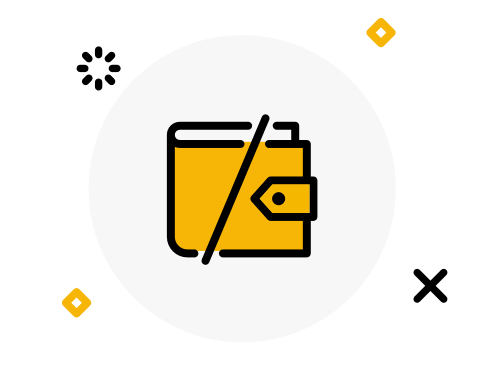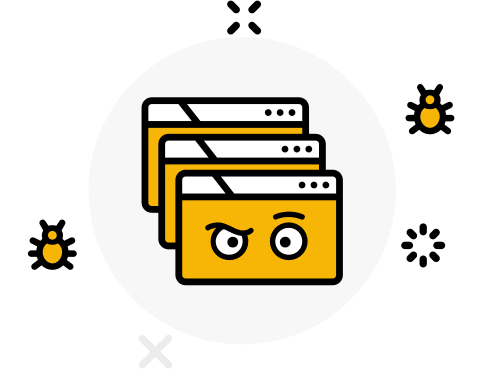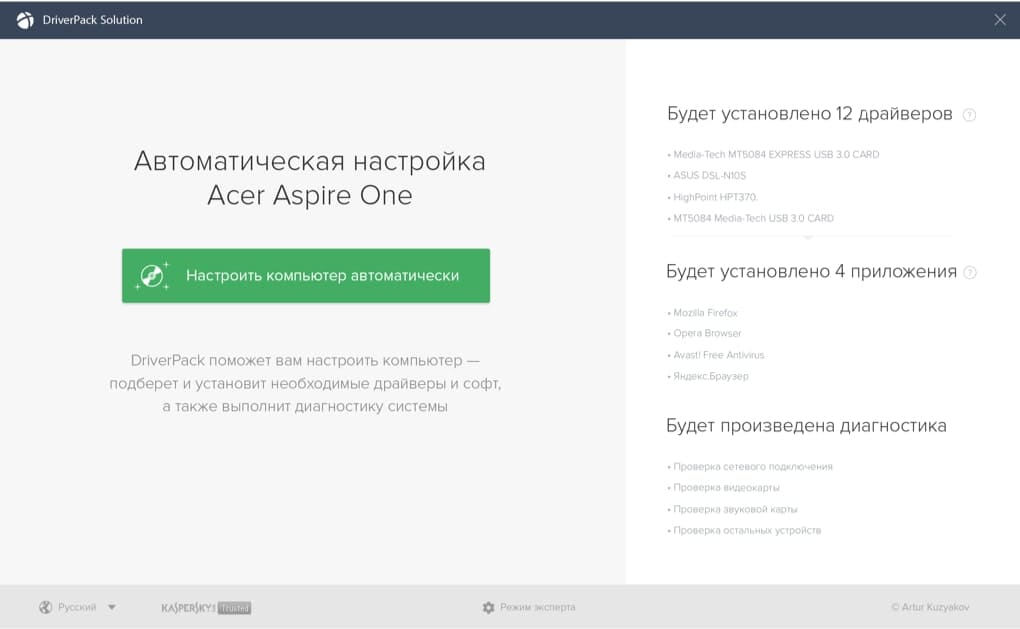DriverPack бесплатно установит драйверы и решит проблемы с любыми устройствами
DriverPack — самый удобный и быстрый способ настроить компьютер
DriverPack — самый удобный и быстрый способ настроить компьютер
Наши партнеры
Opera Software — глобальная компания-разработчик браузеров и программного обеспечения для работы в интернете.
Насчитывает более чем 20-летнюю историю. Opera Software участвует в развитии веб-стандартов в рамках проекта W3C. Продуктами Opera пользуются более 350 млн человек во всем мире.
Штаб-квартира расположена в столице Норвегии — Осло.
Яндекс — глобальная компания-разработчик одноименной поисковой системы и популярных интернет-сервисов.
В России, откуда Яндекс родом, его поисковая доля составляет 56,4% (Яндекс.Радар, март 2018). Компания одна из немногих, кто успешно выдерживает конкуренцию с поисковым гигантом Google.
Штаб-квартира расположена в столице России — Москве.
Avast Software — глобальная компания-разработчик программного обеспечения в области информационной безопасности.
Выпускает самый популярный в мире бесплатный антивирус. Каждый месяц программы от Avast предотвращают 1.5 млрд атак на компьютеры и сети.
Штаб-квартира расположена в столице Чехии — Праге.
Из маленькой программы, написанной на чистом энтузиазме 8 лет назад, мы превратились в компанию, которая помогла настроить компьютеры более чем 40 миллионам людей по всему миру!
За эти 8 лет работы программа стала невероятно быстрее и умнее. Сегодня, DriverPack это самая большая в мире база уникальных драйверов, которая расположена на сверхскоростных серверах по всему миру. Для того, чтобы установка драйверов всегда проходила не только быстро, но и максимально качественно, мы используем технологии машинного обучения, что делает наш алгоритм подбора еще лучше и точнее. При всем этом, нам удалось оставить программу абсолютно бесплатной, чтобы каждый желающий мог ей воспользоваться.
Я и моя команда гордимся нашим продуктом и надеемся, что он станет вашим надежным помощником, который сможет быстро настроить любой компьютер. Мы тратим все наше время, чтобы экономить ваше!
Windows USB/DVD Download Tool
Overview
When you download Windows from Microsoft Store, you have two options: You can download a collection of compressed files, or you can download an ISO file. An ISO file combines all the Windows installation files into a single uncompressed file.
If you choose to download an ISO file so you can create a bootable file from a DVD or USB drive, copy the Windows ISO file onto your drive and then run the Windows USB/DVD Download Tool. Then simply install Windows onto your computer directly from your USB or DVD drive.
When you download the ISO file, you must copy it onto a USB or DVD. When you’re ready to install Windows, insert the USB drive or DVD with the ISO file on it and then run Setup.exe from the root folder on the drive.
This allows you to install Windows onto your machine without having to first run an existing operating system. If you change the boot order of drives in your computer’s BIOS, you can run the Windows installation directly from your USB drive or DVD when you first turn on your computer. Please see the documentation for your computer for information about how to change the BIOS boot order of drives.
Making copies
To install the software, you can make one copy of the ISO file on a disc, USB flash drive, or other media.
After you’ve installed the software and accepted the license terms that accompany the software, those license terms apply to your use of the software. The license terms for Windows permit you to make one copy of the software as a back-up copy for re-installation on the licensed computer. If you do not delete your copy of the ISO file after installing the Windows software, the copy of the ISO file counts as your one back-up copy.
If you need to download the software again, you can go to your Download Purchase History in your Microsoft Store account and access the download there.
Installation
To install the Windows USB/DVD Download Tool:
2. Click Download then Run.
3. Follow the steps in the setup dialogs. You’ll have the option to specify where to install the Windows USB/DVD Download Tool.
You must be an administrator on the computer on which you are installing the Windows USB/DVD Download tool. It requires the Microsoft .NET Framework version 2.0 or higher.
System requirements
Windows XP SP2, Windows Vista, or Windows 7 (32-bit or 64-bit)
Pentium 233-megahertz (MHz) processor or faster (300MHz is recommended)
50MB of free space on your hard drive
DVD-R drive or 4GB removable USB drive
For Windows XP users
The following applications must be installed prior to installing the tool:
Microsoft .NET Framework 2.0 must be installed. It can be downloaded here.
Microsoft Image Mastering API v2 must be installed. It can be downloaded here.
Using the Windows USB/DVD Download Tool
Before you run the Download Tool, make sure you have purchased the Windows ISO download from Microsoft Store and downloaded the Windows ISO file to your drive. If you have purchased Windows but have not yet downloaded the ISO file, you can download the ISO file from your Microsoft Store Account.
To make a copy of your Windows ISO file:
1. Click the Windows START button, and click WINDOWS USB/DVD DOWNLOAD TOOL in the ALL PROGRAMS list to open the Windows USB/DVD Download Tool.
2. In the SOURCE FILE box, type the name and path of your Windows ISO file, or click BROWSE and select the file from the OPEN dialog box. Click NEXT.
3. Select USB DEVICE to create a copy on a USB flash drive or select DVD disk to create a copy on a DVD disk.
4. If you are copying the file to a USB flash drive, select your USB device in the drop-down list and click BEGIN COPYING. If you are copying the file up to a DVD, click BEGIN BURNING.
When your Windows ISO file is copied to your drive, install Windows by moving to the root folder of your DVD or USB drive, and then double-click Setup.exe.
Frequently Asked Questions
Where can I download .NET framework 2.0?
The .NET framework can be downloaded here.
Where can I download Image Mastering API 2.0?
The Image Mastering API can be downloaded here.
What size USB drive is required?
You need a USB drive with a minimum of 4GB of free space.
Can I use my newly created USB drive to install Windows on someone else’s computer?
No. The Windows ISO file on the USB drive is only intended to be used to install Windows on the licensed user’s own computer.
Can I back up to a CD-ROM?
No. The Windows ISO file is too large to fit on a CD.
Can I back up to a Blu-ray Disc?
Yes, as long as your DVD drive can write to a Blu-ray Disc.
IfI have other files on the USB drive will the Windows USB/DVD download tool delete them?
This tool requires the USB drive to be completely blank before the Windows files are copied. This helps ensure that the device is bootable after the copying has completed.
Can I backup to an external hard drive or other device with enough free disk space?
Yes, but this is not recommended. The device must be formatted in order for the device to be bootable. A dedicated USB flash drive would be a better option.
Can I use the Windows USB/DVD Download Tool to back up other files?
No. This tool is only for use with the Windows ISO file purchased from Microsoft Store.
Does the tool support dual-layer DVD discs for burning?
No. Currently, the tool does not support dual-layer DVD discs.
Troubleshooting
The tool is asking me to install the .NET framework and Image Mastering API before I install the tool
If you’re running Windows XP, you must install the .NET Framework 2.0 and the Image Mastering API 2.0 before installing the tool. You can download .NET framework here and you can download the Image Mastering API here.
A restart may be required after installing the .NET framework and the Image Mastering API.
When creating a bootable USB device, I am getting an error about bootsect
To make the USB drive bootable, you need to run a tool named bootsect.exe. In some cases, this tool needs to be downloaded from your Microsoft Store account. This may happen if you’re trying to create a 64-bit bootable USB device from a 32-bit version of Windows. To download bootsect:
1. Login to your Microsoft Store account to view your purchase history.
2. Look for your Windows purchase.
3. Next to Windows, there is an Additional download options drop-down menu.
4. In the drop-down menu, select 32-bit ISO.
5. Right-click the link, and then save the bootsect.exe file to the location where you installed the Windows USB/DVD Download Tool (e.g. C:\Users\username\AppData\Local\Apps\Windows USB DVD Download Tool).
6. Once the file has been saved, go back to the Windows USB/DVD Download Tool to create your bootable USB device.
My USB drive is not in the list of available devices
If you don’t see your USB drive in the list of available devices, please make sure the drive is inserted in the USB port, and then click the Refresh button beside the list of available drives.
I inserted a blank DVD in my DVD-ROM drive, but the Windows USB/DVD Download Tool doesn’t recognize it
If there are multiple drives on the system, the tool will select the first one that is capable of burning DVDs. If you have multiple DVD-R drives, try inserting the blank DVD into another DVD-R drive. If that doesn’t help, please make sure that your disc isn’t damaged and that your DVD-R drive is operational. Contact Product Support if issues continue to arise.
I inserted a blank DVD in my DVD-ROM drive, but the tool won’t let me burn it
Make sure the disc isn’t a dual-layer DVD disc. Currently, dual-layer discs are not supported within the tool.
Drive tools for windows
Allowed:
— usage in any environment, including commercial
— include in software products, including commercial
— include on CD/DVD of computer magazines
Not allowed:
— modify any of the files
— offer for download by means of a «downloader» software
I don’t ask for donations but some users insist, so:
PayPal
| RemoveDrive V3.3.1 — Safe removal of drives |
| RemoveDrive prepares drives for «Safe Removal» by commandline. It works with drives only. For other device types there is DevEject by Matthias Withopf. Caution: With V2.4 the parmeter for showing debug information changed to -dbg. -d is now for removing the drive only instead the whole device. RemoveDrive can be used with all types of drives. Started with -L it tries to remove the drive in an endless loop until success or until canceled. For drives mounted into NTFS folders the full or relative path of the folder can be used: Used with multislot-cardreaders it would remove the whole reader, regardless of the given slot. For removing a card only, use my EjectMedia tool, see below. Instead the drive letter one of the drive’s device ID strings can be used. The friendly name can be used as «SanDisk Extreme» or the hardware ID of the USB device, like USB\VID_1234&PID_5678. If started with admin privileges or the USBDLM command interface available, then a removed USB drive ends up with problem code 21 and can be reactivated by means of RestartSrDev or UsbDriveInfo. RemoveDrive can be started from the drive to remove. Because a running EXE on a drive prevents a drive being prepared for safe removal it creates a temporary, self deleting copy and starts it with the same parameters. The returned errorlevel is 4 then. To be drive letter independent, use . instead a drive letter. The current drive is removed then. To remove the drive of the RemoveDrive.exe use \ as drive. If the removal fails then someone still accesses the drive. This can be something obvious like an open Word document or a mounted TrueCrypt container or some kind of monitoring tool like a virus scanner. A network share on the drive that has been used makes the removal fail too. When started with parameter -L and the removal failed then the E key can be pressed to perform a media eject after locking and dismounting the volume. Since V3.3 the safe removal can be forced, either by giving parameter -f or -l and pressing the F key when asked for. Download latest release: removedrive.zip Last update: 30 April 2020 For programmers I’ve made a demo project which shows the essentials: A free alternative to the Windows tray icon is «HotSwap!»: |
| RestartSrDev V3.0 — restarts «Safely Removed» devices which have the «Code 21» or «Code 47» problem code |
| If the & char is used in a parameter then the whole parameter must be enclosed by quotation marks. Otherwise the & char splits the command line into two seperate ones which will not work. Admin rights are required (or an active USBDLM command interface). 0 — successfully restarted at least one device After using the Windows «Safely Remove Hardware» facility, a device gets the problem code 47, which is a constant from the cfg.h: CM_PROB_HELD_FOR_EJECT. As far as known, a device with this problem code cannot be reactivated. The only way for a USB device is to restart the hub which this device is attached to. This can be a root hub or a standard hub. But of course this will restart all devices attached to this hub. Therefore RestartSrDev performs the restart of the parent devices only if the device to reactivation is the only one attached there or the parmeter -f (force) is set. But sometimes devices have problem code 21 after the safe removal, which is CM_PROB_WILL_BE_REMOVED. Devices with this problem code can be reactivated by restarting them. This can be done by means of the Microsoft DEVCON tool (DEVCON restart DeviceInstanceID). My tool restarts only devices with the problem code 21 or 47, so usually you can just start it with a asterisk as paramerter to restart all devices with code 21. It seems that it depends on the API call which is used to perform the safe removal. There are two: CM_Query_And_Remove_SubTree requires admin privileges while CM_Request_Device_Eject works for restricted users too. My tool RemoveDrive tries CM_Query_And_Remove_SubTree first and if this fails then it tries CM_Request_Device_Eject. So, if you have admin privileges (or a USBDLM V4.8 with activated command interface) and removing a drive by means of RemoveDrive, then it is possible to reactivate the drive by means of RestartSrDev. Code 47 devices can be reactivated by restarting their parent device (e.g. a USB hub) or (since V3.0) by restarting the device’s USB port, which works under XP, Windows 8 and 10 with the Microsoft standard USB drivers. Last update: 21 June 2020 |
| EjectMedia V3.2.1 — ejects a media from a drive |
| It ejects a media from a drive rather that removing the whole device by commandline. Ejecting the media only is especially suitable for internal cardreaders. On CD/DVD and ZIP drives the media is physically ejected while on flash cardreaders the media is ejected logically only. It cannot being accessed before it’s removed and inserted again. Windows passes the eject request down to the drive even it is a fixed drive. Most fixed drives answer «invalid function» but some respond success and «no media» afterwards. Under XP this is not allowed for restricted users but this can be enabled by a policy. As RemoveDrive, EjectMedia can be started from the drive to remove. Last update: 21 April 2020 |
| LoadMedia V1.5 — Loads a media or brings a volume online |
| LoadMedia is the counterpart of EjectMedia — it loads CD/DVD media by closing the tray or brings a offline volume online. But loading a media has a physical effect on CD/DVD drives with a tray only. ZIP drives have no mechanic for loading a media. An ejected card of a cardreader or USB flash drive might be reactivated or not, it depends on the device. Last update: 4 Jan 2018 |
| EjectTcv V3.2.0 — ‘ejects’ a TrueCrypt or VeraCrypt Volume |
| EjectTcv (EjectTrueCryptVolume) is a commandline tool which ‘ejects’ a TrueCrypt volume. Since V2.7 it works with VeraCrypt too. Ejecting with VeraCrypt since V1.18 works since EjectTcv V2.8.4. Advantages over original TrueCrypt tool:
I used the term ‘eject’ because under Windows the term ‘dismount’ (as used by the original tool) means only to disconnect the file system but keeping the volume present. If you object that this is the case for eject too then you are right. Remove or release would have been better terms. It can be started from the volume to eject, it creates a temporary copy then. Samples: Returns errorlevels: Last update: 8 March 2018 |
| ReMount V2.1 — reassigning mountpoints (change drive letters) |
| Using ReMount you can quickly change a drive letter without clicking thru the Windows disk management. E.g. to change drive F: to U: If both letters are in use and shall be swapped then use parameter -s For nonsense operations, as remonting the Windows system drive or mounting a local drive to a letter used by a network drive, use parameter -f (force). Furthermore -f can be used to remount a drive to a drive letter which is in use. The drive which uses the target letter is remounted to the first free letter. Instead of drive letters you can use NTFS mount points too. Admin privileges are required. A graphical alternative for quickly changing mount points is UsbDriveInfo, started with admin privileges you can right-click a volume and select «Drive Letter». The tool shows Non-USB drives too if this is activated in the Options menu. Last update: 09 March 2019 |
| FFB — Flush File Buffers |
| FFB is a commandline tool which flushes the write cache of one or more storage volumes. It is similar to the Unix sync command or the Sysinternals Sync tool. The Sysinternals sync tool can flush volumes only which have a drive letter. And it forgets drive Z: when called without parameters. Sleeping drives are skipped unless -f is given. VHD, TrueCrpyt and VeraCrypt volumes are resolved to their physical drives to check for being at sleep, other file hosted volumes are not, so unwanted disk wakeups might happen. Flushing and purging a volume’s cache requires admin privileges, so, restricted users cannot do that. Last update: 10 December 2017 |
| AttachVHD V1.0 — attaches VHDs by command line |
| Windows 7 and higher have build-in VHD support, XP, Server 2003, Vista, Server 2008 need Microsoft Virtual Server 2005 installed in its default folder (%ProgramFiles%\Microsoft Virtual Server\Vhdmount), here AttachVHD looks for its vhdmount.dll. Admin previlegs are required or (under Windows 7 and higher) USBDLM V5.4.6+ with CommandInterface 0x100 active. Last update: 31 December 2019 |
| DriveCleanup V1.6.1 — remove nonpresent drives from the registry |
| DriveCleanup is a command line tool which does what you could do manually in the Windows Device Manager or my means of DeviceCleanup, it removes all currently non-present USB Storage Devices, Disks, CDROMs, Floppies, Storage Volumes and WPD devices from the device tree. Furthermore it removes orphaned registry items related to these device types. Started with parameter -T (like test) it shows which devices it would remove. Started with admin privileges and without a parameter it does its job without further inquiry. To remove certain types of devices there are the parameters -U -D -C -F -V -W and -R, see DeviceCleanup.txt. Sample to remove abandoned registry entries only: Under x64 editions of Windows only the included x64 version works. Admin privileges are required for actual cleanup, without it requests to switch into the test mode. Since V1.0 it removes non-USB drives if they have a removal policy > 1 (EXPECT_ORDERLY_REMOVAL or EXPECT_SURPRISE_REMOVAL). When started standalone it waits for a keystroke at the end. This can be skipped by param -n or by starting it minimized or hidden. Last update: 10 May 2020 |
| ListDosDevices |
| Drive letters are references to kernel objects thru ‘symbolic links’. For historical reasons they are sometimes called ‘DOS device names’. ListDosDevices shows which kernel-name is behind each drive letter. Sample: Here are A: Floppy C: + D: partitions of a fixed drive E: + F: CD or DVD drives I: Virtual CDROM created by UltraISO P: Windows Network drive Q: Novel Network drive S: Subst drive U: USB flash drive (Win2000, XP, 2003; Since Vista the kernel-name looks like a partition.) V: VeraCrypt volume X: Virtual drive created by WinMount Y: TrueCrypt volume |
| DeleteDosDevice |
| When a software crashes which had created virtual drives under a drive letter, then it leaves a dead drive letter behind. Started again the software in question might be able to fix this but somtimes it just sees a drive letter in use. In such cases you can try to remove the dead drive letter by means of DeleteDosDevice. Sometimes the tool reports success because Windows sayed so, but the drive drive letter persists 🙁 Sample for removing X: Since V0.4 in can delete any type of DOS-device, e.g. a serial port as «COM10». Last update: 19 Feb 2012 |
| RescanDevices |
| When an IDE or SATA drive has been prepared for safe removal it can be reactivated by a scan for new hardware. That’s what this tool initiates. It is a non interactive, invisible Windows application. It does the same as Microsoft’s tool DEVCON when called with parameter ‘rescan’, but no console window pops up. |
| XP SystemRestore Enable/Disable |
| Enabling or Disabling XP SystemRestore for one or more drives. Sample: Disable SystemRestore on drive D: Sample: Disable SystemRestore on drives D: to Z: SRE enables the XP SystemRestore on certain drives. If the SystemRestore is enabled or disabled for the system drive then this is done of all other local drives too! This tool is for XP only. W2K has no system restore and since Vista the SystemRestore deals with the system drive only. |
| AutoRun Settings V1.4 |
| AutoRunSettings gives easy access to the basic Windows AutoRun settings. AutoRun can be disabled depending on the drive type and depending on the drive letter by Explorer Policies. They are valid under HKEY_LOCAL_MACHINE and under HKEY_CURRENT_USER. If a value exist under HKEY_LOCAL_MACHINE then the same value under HKEY_CURRENT_USER is ignored. For AutoRun and AutoPlay to work the service «Shell Hardware Detection» (ShellHWDetection) is required. If AutoRun is deactivated by the above settings then keeping this service running is in vain under XP unless autoruns for non drive devices are required. Under Vista and Windows 7/8/10 the WIA service relies on it. These settings have effect only for the moment when a drive is attached. They do not deactivate AutoRun when the drive is opened manually in the Windows Explorer. This is changend with the Microsoft XP Patch KB950582, availlable since August 2008, see here: An alternative is to completely disable the autorun.inf mechanisms as suggested by the US-CERT. This prevents the Windows behaviour beeing changed by an autorun.inf file but the selection dialog is still working. Another setting for CDROM drives is the value «AutoRun» under HKLM\SYSTEM\CurrentControlSet\Services\Cdrom. Despite the name it controls the ‘Auto Insert Notification’, also called ‘Media Change Notification (MCN)’. When deactivated media changes are not detected, therefore AutoRun does not work. But this is a side effect only. This should stay activated. Microsoft says «Do not disable the MCN message unless you have no alternative». One reason to deactivate this is a cyclic flashing HDD-LED which happens on some computers with MCN enabled. For changing system global settings administrator privileges are required. So under Vista and Windows 7/8/10 you have to right click AutoRunSettings in the Explorer and select «Start as administrator» or create a link to it with this setting. Screenshot (AutoRun completely deactivated): Last update: Dec 2010 |
| USB-WriteCache V0.1 |
| My means of USB-WriteCache you can force the activation of a write-cache for USB drives. It reads/writes the registry value WriteCacheEnableOverride under HKLM\SYSTEM\CurrentControlSet\Enum\(DeviceInstanceID)\Device Parameters\Classpnp. For making a setting it needs admin privileges, otherwise you get an «Access is denied». New settings take effect after the drive is re-attached or the system is restarted. Last update: 12.2.2010 |
| MaximumTransferLength since Windows 7 SP1 |
| Since Windows 7 SP1 the block size of USB data transfers of USBSTOR drives can be changed for each device from the default of 64 KB. A larger transfer length reduces protocol overhead and therefore increases the transfer speed. The setting was introduces in 2011 with a Hotfix 2581464. Today an updated Windows 7 SP1 is good enough — no need for the hotfix. The setting is made in the registry on a per USB device base: Under HKEY_LOCAL_MACHINE\SYSTEM\CurrentControlSet\Control\usbstor there are already some keys for devices which need special treatment as Apple iPods (05AC12xx and 05AC13xx). The keys are made of eight hex digits, four for the USB vendor ID and four for the product ID. Even not documented the key obviously supports the x character as a wildcard. The factory keys consist an undocumented value DeviceHackFlags which gives these devices a special treatment. By means of a DWORD value named MaximumTransferLength the block size of data transfers can be increased: Default are 64 KB, maximum value 2 MB. Some devices cannot handle larger blocks and some older USB hubs seem to cause problems too. Therefore 64 KB are still default, even under Windows 8 and 10. But Windows 8 and 10 support the USB Attached SCSI (UAS) protocol which uses a larger transfer length offhand, so tuning is needed for USBSTOR devices only. After changing the value the device must be re-attached or restarted. I’ve made a little tool for this, it can perform a read speed test, make the setting and restart the device. It must be started «As Administrator»: The Hotfix documentation states that the value must be «between 65535 (64 KB) and 2097120 (2 MB)». But these values are unusual for a data transfer buffer, here multiples of a physical page (4096) make sense and indeed I got an instant blue screen when using 2 Ч 65535 = 131070. Therefore the tool uses 65536 (64 KiB) to 2097152 (2 MiB). |









